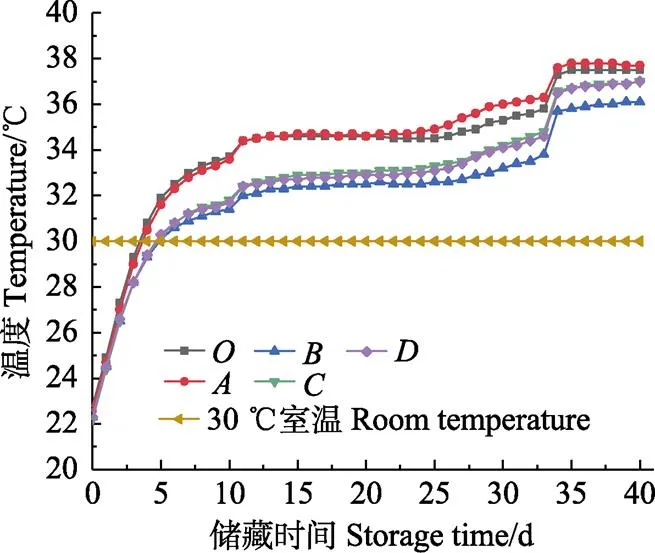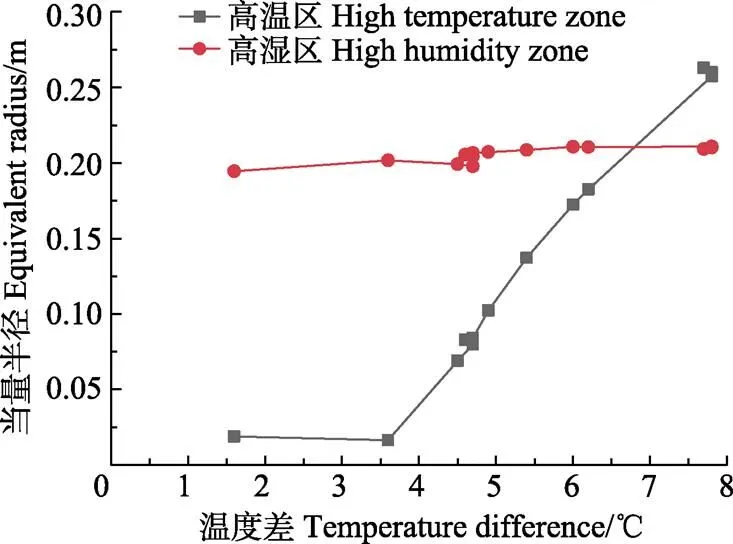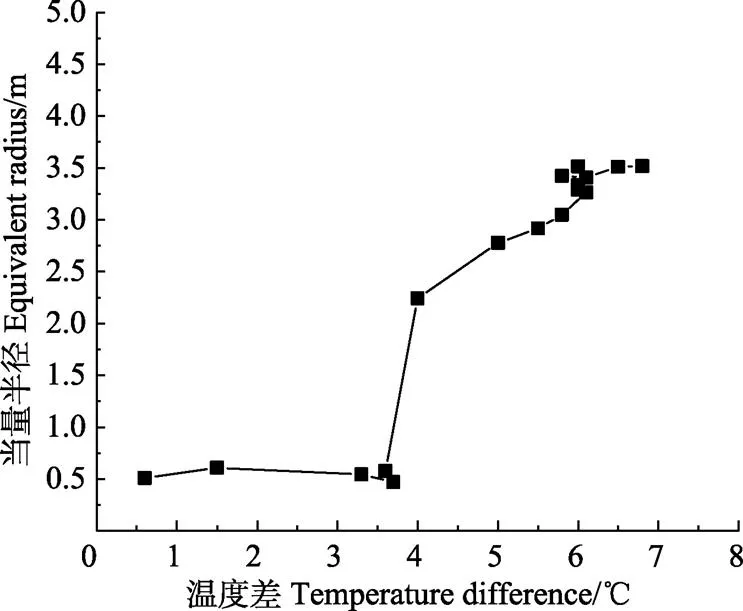玉米粮堆霉变发热过程中的温湿度场变化规律研究
2019-02-23王小萌吴文福张忠杰吴子丹
王小萌,吴文福,尹 君,张忠杰,吴子丹※,姚 渠
玉米粮堆霉变发热过程中的温湿度场变化规律研究
王小萌1,2,吴文福1,尹 君2,张忠杰2,吴子丹1※,姚 渠2
(1. 吉林大学生物与农业工程学院,长春 130022;2. 国家粮食和物资储备局科学研究院,北京 100037)
为模拟储粮粮堆局部含水率偏高引起的霉变发热现象,进而研究此现象中温、湿度场的变化规律,该文在试验仓内湿基含水率14.0%的玉米粮堆中心加入湿基含水率18.2%的玉米,在30 ℃室内储藏40 d。试验粮堆由于霉变引起自发热。试验过程中,通过计算玉米粮堆中垂面内高温区和高湿区的面积变化,从而揭示玉米粮堆霉变发热过程中温、湿度场的变化规律。试验结果表明,粮堆中垂面高湿区面积缓慢扩大,高温区面积开始扩大缓慢,但在与周围粮温最高温差升至3.7 ℃后,面积扩大速率加快,且高温区与高湿区面积的当量半径与温度差D成正比,此正比关系经过了粮库浅圆仓的验证。这为进一步定量分析粮食仓储过程中的高温区和高湿区扩散提供了依据。
作物;温度;湿度传感器;玉米;温度场;相对湿度场;霉变发热
0 引 言
中国玉米种植范围广,产量高,是重要的粮食及经济作物之一。在储藏过程中玉米粮堆霉变发热一直是比较普遍的问题。
对于储粮粮堆发热的起因,国内外已经做了大量的研究。微生物作用,害虫大量滋生,粮食呼吸作用,杂质聚集等均可以引发粮堆发热[1]。其中,虫[2]、霉[3]是引起粮堆发热的重要因素[4],但是如果昆虫密度不高,仅依靠昆虫自身呼吸作用引发粮堆发热的几率比高水分粮食霉变引发粮堆发热的几率低[5-6]。储粮真菌呼吸作用是粮堆发热的主要热源,且虫害一般会发生在霉变发热之后[7]。
粮食储藏过程中影响储粮的主要霉菌是曲霉和青霉[8],而影响霉菌生长的重要因素是温度和水分[9],因此,储粮霉变发热过程中,温度、水分与霉变的关系是需要密切关注的问题。针对这个问题,国内外学者做了大量的研究。Koehler[10]研究了含水率对玉米霉变的影响。Jian等[11]研究了不同温度和含水率下虫害和微生物的演替规律。Huang等[12]研究了不同温度和含水率的玉米粮堆CO2产生速率。张航等[13-16]分别研究了中国小麦、玉米、水稻和大豆霉变与温度和水分的关系。
在储粮霉变发热过程中,王小萌等[17]对霉变分布与粮堆温度场和湿度场之间的关系进行了分析。Wallace等[18]研究了发热粮堆的水分迁移,并发现粮堆发热会引起发热点上层粮堆含水率增加,下层含水率降低[19]。张中涛[20]利用有限元法研究了小麦呼吸作用对粮堆温度场、水分场的影响。除此之外,国内外学者也对储粮发热点的温度变化进行了研究。Zhang等[21]研究了2种高水分小麦的发热过程,并建立了发热量与时间的指数模型。Wilson[22]建立了粮堆霉变发热过程中热产生速率和CO2产生速率的方程,但是方程不适用于低水分粮食。Jia等[23-24]分别利用有限元和离散元建立了粮堆内存在发热点时的温度分布模型。但是,目前对粮堆霉变发热过程中,温、湿度场在空间上的变化规律研究甚少。
本文利用储粮霉变自发热引发粮堆内温度传递和水分迁移。通过计算玉米粮堆内高温区和高湿区的面积,研究粮堆霉变发热过程中温、湿度场在空间上的变化规律,以期对粮食仓储过程中的粮情调控做出指导。
1 材料与方法
1.1 试验样品
本试验采用的“先玉”玉米样品初始平均湿基含水率为23%(下文提及的含水率均为湿基含水率),质量密度为698 g/L,杂质质量分数为1.0%,样品初始真菌孢子数<104个/g,无储藏真菌。
1.2 试剂及仪器
多参数粮情检测系统[17]:中国深圳市东大恒丰科技有限公司;DHG—9140型电热恒温鼓风干燥箱:上海精宏实验设备有限公司;NIKON E100显微镜:日本尼康公司。去离子水作为试验用水。
1.3 试验方法
1.3.1 试验仓装置
为模拟浅圆仓中粮堆局部含水率偏高引起的局部霉变发热现象,依据相似性设计原理和浅圆仓仓型,选用圆形的试验仓[17](图1),并进行改进,去除仓底的保温隔热材料,将仓底中心位置开1个内直径为0.08 m的通气孔,目的是有利于试验仓内外气体进行交换,确保试验仓内氧气供应充足。
1.3.2 样品处理
将平均含水率为23%的玉米进行除杂、清理,玉米样品铺成厚度为0.02 m的薄层,在室外通风环境下,将含水率降低。玉米入仓储藏安全水分为14%左右[25]。储粮实践发现由于储粮水分分布不均、杂质聚集、水分迁移等因素的影响,玉米粮堆局部含水率可增至16~18%。粮堆内的热传递和水分迁移会受到粮堆高度和跨度等的影响[26],鉴于试验仓底面直径和高度较小,为便于观察粮堆霉变发热后的温湿度迁移现象,因此试验用粮的高、低含水率可分别设为18%左右和14%左右。
1.3.3 储藏模拟设置
试验仓内玉米粮堆总高度为0.60 m,高水分玉米(18.2%)和低水分玉米(14.0%)的分布如图1a所示,2种含水率的粮堆体积比为1∶4,将试验仓储藏在温度为30 ℃的室内,以期模拟储粮过程中由于粮堆局部含水率偏高引起的粮堆霉变发热现象。2种含水率的玉米的初始粮温为22 ℃,初始平均相对湿度分别为67%和90%。
1.4 测量指标及方法
1.4.1 危害真菌孢子
参考储粮真菌检测标准[27],检测样品的真菌孢子数。
1.4.2 温湿度
利用温湿度传感器实时监测玉米粮堆内温湿度变化。为了充分重现温湿度场在2种含水率玉米中的分布,在借鉴文献[17]温湿度传感器布置的基础上,增加含水率14.0%玉米中的传感器个数。粮堆内温湿度传感器布置如图1。
1.4.3 含水率
参考ASAE标准[28],称取15.0 g玉米籽粒样品,放在干燥铝盒内,在103 ℃烘箱内干燥72 h,检测样品的含水率。
1.5 数据处理
1.5.1 温湿度场的建立
选取粮堆中垂面温湿度传感器检测到的温度和相对湿度数据,再运用温湿度拟合算法得到粮堆内各点的温度和相对湿度,通过Matlab 模拟软件重现粮堆的温度场和湿度场,温湿度场拟合算法如式(1)~(2)[29]。
由数值计算方法可知,已知个离散数据(x,(x))=1,2,3,…,在[,]上满足xÎ[,],且(x)=(x),则


注:“●”表示粮堆温度和相对湿度的监测位置,O点为含水率18.2%的玉米粮堆中心。
1.5.2 当量半径的计算
利用Matlab软件对粮堆中垂面的温、湿度场云图进行高温区和高湿区面积求解,主要步骤是:导入云图图片,灰度处理,二值化处理,计算高温区和高湿区面积。本文中,将高温区和高湿区的面积按照圆形处理,计算出圆的半径,作为高温区和高湿区的当量半径。
2 结果与分析
2.1 温度和相对湿度变化
图2和图3分别是玉米粮堆储藏0、20和40 d时粮堆中垂面的温度场和相对湿度场云图。由图2可知,储藏温度为30 ℃,平均含水率为18.2%的玉米粮堆中由于微生物作用逐渐出现了发热点。微生物迅速生长,发热点面积不断扩大,发热点最高温度和周围粮堆温度的温差不断升高,最大温差达到8 ℃。研究表明,粮堆内的微气流运动是引起粮堆内温度传递和水分迁移的主要因素[30]。从图3可以看出,粮堆内微气流运动引起粮堆内水分向粮堆上层迁移。试验结束后,取样检测真菌孢子数,点、点、点、点、点的真菌孢子数分别为6.3´106,6.9´106,2.1´106,5.4´106,5.7´106个/g,优势真菌为亮白曲霉和黄曲霉。

注:O、A、B,、C、D在温度场云图中是共用的,下同。

图3 玉米粮堆储藏0、20和40 d时中垂面相对湿度场云图
2.2 高温区与高湿区面积变化
粮堆内发热点周围平均粮温为30 ℃,因此本文中的高温区选取玉米粮堆中垂面温度高于30 ℃的区域。亮白曲霉和黄曲霉是引起本文粮堆发热的主要霉菌,而相对湿度高于75%时易于亮白曲霉和黄曲霉生长,因此,本文中的高湿区选取玉米粮堆中垂面相对湿度高于75%的区域。图4是试验过程中,玉米粮堆中垂面、、、、5点的温度变化图。图5是玉米粮堆中垂面的高温区和高湿区面积随时间的变化图。由图5可知,在试验的40 d内,高湿区面积增加缓慢;高温区面积在试验第25 d后迅速增加,结合图4分析,可发现试验第25 d后粮温升高加快,导致高温区面积迅速扩大,这主要是因为黄曲霉和亮白曲霉大面积生长,产生大量的热。

图4 玉米粮堆中垂面不同点温度变化
参考当量直径的定义,本文中将高温区和高湿区的面积按照圆形处理,计算出圆的半径,作为高温区和高湿区的当量半径。温度差是粮堆内湿热转移的动力源[31-32]。因此,建立玉米粮堆高温区和高湿区当量半径与温度差D的关系(图6)。由图6可知,高湿区面积的当量半径与温度差成正比;当温度差高于3.7 ℃即高温区最高温度高于33.7 ℃后,发热区开始快速向周围扩散,这与粮堆的导热系数小有很大关系,粮堆导热系数小,导致粮堆霉变产生的热量难以快速传递出粮堆,很容易聚集在粮堆内;高温区面积的当量半径与温度差成线性正相关,且D/D=0.058 (2=0.99)。储粮霉变发热过程中,发热区域的扩散速率会受到热传导和热对流的共同作用,由于试验仓体积小,高度低,热对流现象微弱,因此粮堆内的热量传递和水分迁移主要受到热传导的影响。下面用实仓对高温区当量半径与温度差的关系进行验证。

图5 高温区和高湿区面积随储藏时间的变化

图6 高温区和高湿区面积的当量半径与温度差的关系
2.3 实仓验证
以中国某粮库的浅圆仓粮温数据验证上述正比关系。此浅圆仓为钢屋盖,仓内直径为25.0 m,装粮高度为15.6 m,杂质质量分数为1.5%,粮堆质量密度为698 g/L,储量为5 756.9 t。所储玉米的平均含水率为13.8%,粮堆局部偏高水分区域的平均含水量为14.8%。粮堆内局部含水率偏高,导致出现发热点。通过计算粮堆中垂面高温区的面积变化,得到高温区当量半径与温度差的关系,如图7。

图7 浅圆仓中垂面高温区的当量半径与温度差的关系
在之前研究[17]中,利用外加热源引起小麦粮堆内的温湿度迁移,试验过程中没有出现由于粮堆霉变引发的发热点,以此作者研究了储粮真菌分布和温湿度的关系。此文中,利用高水分玉米自身霉变出现发热点,模拟储粮粮堆局部含水率偏高引起的粮堆霉变发热,发现粮堆高温区当量半径与温度差的正比例关系,鉴于此文中没有找到高温区当量半径与温度差的具体定量关系,还需进行更深入的研究。
3 结 论
模拟试验仓中,由18.2%和14.0% 2种含水率的玉米组成的粮堆在30 ℃恒温室内储藏,4 d后,亮白曲霉和黄曲霉大量生长引发粮堆出现明显发热点。
玉米粮堆霉变发热过程中,主要受热传导影响,高温区与高湿区面积不断扩大。在高温区与周围粮温最大温差从3.7升高至8 ℃的过程中,高温区和高湿区面积的当量半径与温度差呈正相关。该相关性也经实仓数据得到了验证。
试验仓和浅圆仓高温区与周围粮温的温度差均升高3.7 ℃后,高温区面积才开始迅速扩大,但是浅圆仓热对流强烈,导致浅圆仓高温区扩散速率远大于试验仓中高温区扩散速率。
[1] 房强. 新粮入仓后发热的预防和处理措施探讨[J]. 粮食储藏,2016,45(3):53-56. Fang Qiang. Discussion on prevention and treatment measures of new grain storage heating[J]. Grain Storage, 2016, 45(3): 53-56. (in Chinese with English abstract)
[2] Sinha R N. Insects and mites associated with hot spots in farm stored grain[J]. Canadian Entomologist, 1961, 93 (8): 609-621.
[3] Wallace H A H, Sinha R N. Fungi associated with hot spots in farm stored grain[J]. Canadian Journal of Plant Science, 1962, 42(1): 130-141.
[4] Sinha R A, Wallace H A H. Ecology of a fungus-induced hotspot in stored grain[J]. Canadian Journal of Plant Science, 1965, 45(45): 48-59.
[5] Cofie-Agblor R, Muir W E, Sinha R N. Comparative heat of respiration of five grain beetles in stored wheat[J]. Postharvest Biology and Technology, 1995, 5 (1/2): 167-175.
[6] Mani S. Computer modelling of insect-induced hot spots in stored wheat[D]. Manitoba: University of Manitoba, 2001.
[7] Francis F L. Integrated management of the risks of stored grain spoilage by seedborne fungi and contamination by storage mould mycotoxins: An update[J]. Journal of Stored Products Research, 2017, 71: 22-40.
[8] Pronyk C, Muir W E, Ndg W,et al. Carbon dioxide production and deterioration of stored canola[J]. Canadian Biosystems Engineering, 2004, 46(3): 25-33.
[9] Mohapatra D, Kumar S, Kotwaliwale N, et al. Critical factors responsible for fungi growth in stored food grains and non-chemical approaches for their control[J]. Industrial Crops and Products, 2017, 108 : 162-182.
[10] Koehler B. Fungus growth in shelled corn as affected by moisture[J]. Journal of Agricultural Research, 1938, 56(4): 291-307.
[11] Jian F, Jayas D S. The ecosystem approach to grain storage[J]. Agricultural Research, 2012, 1 (2): 148-156.
[12] Huang H, Danao M G C, Rausch K D, et al. Diffusion and production of carbon dioxide in bulk corn at various temperatures and moisture contents[J]. Journal of Stored Products Research, 2013, 55 (4) : 21-26.
[13] 张航,黄淑霞,蔡静平,等. 小麦临界水分附近微生物活动的特点[J]. 河南工业大学学报(自然科学版),2010,31(5):30-33. Zhang Hang, Huang Shuxia, Cai Jingping, et al. Characteristics of microbial activitity near critical moisture content of wheat[J]. Journal of Henan University of Technology(Natural Science Edition), 2010, 31(5): 30-33. (in Chinese with English abstract)
[14] 唐芳,程树峰,张海洋,等. 稻谷储藏真菌危害早期预测的研究[J]. 粮食储藏,2015,44(1):24-27. Tang Fang, Cheng Shufeng, Zhang Haiyang, et al. Study on the forecasting fungal growth in stored paddy[J]. Grain Storage, 2015, 44 (1): 24-27. (in Chinese with English abstract)
[15] 程树峰,唐芳,欧阳毅,等. 大豆储藏真菌危害早期预测的研究[J]. 中国粮油学报,2015,30(7):77-80. Cheng Shufeng, Tang Fang, Ouyang Yi, et al. The early prediction of damage of fungus during soybean storage[J]. Journal of the Chinese Cereals and Oils Association, 2015, 30(7): 77-80. (in Chinese with English abstract)
[16] 欧阳毅,祁智慧,李春元,等. 玉米储藏真菌早期预测的研究[J]. 粮油食品科技,2017,25(5):52-55. Ouyang Yi, Qi Zhihui, Li Yuanchun, et al. Early prediction of fungus hazard during corn storage [J]. Science and Technology of Cereals, Oils and Foods, 2017, 25(5): 52-55. (in Chinese with English abstract)
[17] 王小萌,吴文福,尹君,等. 基于温湿度场云图的小麦粮堆霉变与温湿度耦合分析[J]. 农业工程学报,2018,34(10):260-266. Wang Xiaomeng, Wu Wenfu, Yin Jun, et al. Analysis of wheat bulk mould and temperature-humidity coupling based on temperature and humidity field cloud map[J]. Transactions of the Chinese Society of Agricultural Engineering (Transactions of the CSAE), 2018, 34(10): 260-266. (in Chinese with English abstract)
[18] Wallace H A H, Sinha R N, Mills T. Fungi associated with small wheat bulks during prolonged storage in Manitoba[J]. Canadian Journal of Botany, 1976, 54(12): 1332-1343.
[19] Sinha R N,Wallace H A H. Ecology of insect-induced hot spots in stored grain in western canada[J]. Researches on Population Ecology, 1966, 8(2): 107-132.
[20] 张中涛. 具有吸湿和呼吸特性的仓储粮堆内热湿耦合传递规律的研究[D]. 济南:山东建筑大学,2015. Zhang Zhongtao. Research of Coupled Heat and Moisture Transfer in Hygroscopic and Respiration Bulk During the Warehouse Storage[D]. Jinan: Shandong Jianzhu University, 2015. (in Chinese with English abstract)
[21] Zhang Q, Muir W E, Sinha R N, et al. Heat production in wet wheat under adiabatic conditions[J]. Canadian Agricultural Engineering, 1992, 34(3): 233-238.
[22] Wilson M T. A model for predicting mould growth and subsequent heat generation in bulk stored grain[J]. Journal of Stored Products Research, 1999, 35(1): 1-13.
[23] Jia Canchun, Sun Dawen, Cao Chongwen. Mathematical simulation of temperature fields in a stored grain bin due to internal heat generation[J]. Journal of Stored Products Research,2000, 43: 227-233.
[24] Rusinek R, Kobylka R. Experimental study and discrete element method modeling of temperature distributions in rapeseed stored in a model bin[J]. Journal of Stored Products Research, 2014, 59: 254-259.
[25] 李兴军,王双林,付鹏程. 采用水分解吸等温线分析粮食安全水分的研究[J]. 粮食加工,2017,42(5):30-36. Li Xingjun, Wang Shuanglin, Fu Pengcheng. A study on the safe storage moisture of cereals and oils with moisture desorption isotherms[J]. Grain Processing, 2017,42(5): 30-36. (in Chinese with English abstract)
[26] 王远成,潘钰,尉尧方,等. 仓储粮堆内部自然对流和热湿传递的数学分析及验证[J]. 中国粮油学报,2017,32(9):120-125. Wang Yuancheng, Pan Yu, Yu Yaofang, et al. Mathematical analysis and validation for natural convective heat and moisture transfer in grain bulk during sealed storage[J]. Journal of the Chinese Cereals and Oils Association, 2017, 32(9): 120-125. (in Chinese with English abstract)
[27] 国家粮食局. 粮油检验-储粮真菌检测-孢子计数法:LS/T 6132-2018 [S]. 北京:中国标准出版社,2018:03.
[28] ASAE. Moisture measurement-unground grain and seeds: S352. 2 -2012 [S]. Michigan: ASABE, 2012:11.
[29] 尹君,吴子丹,张忠杰,等. 不同仓型的粮堆温度场重现及对比分析[J]. 农业工程学报, 2015, 31(1): 281-287. Yin Jun, Wu Zidan, Zhang Zhongjie, et al. Comparison and analysis of temperature field reappearance in stored grain of different warehouses[J]. Transactions of the Chinese Society of Agricultural Engineering (Transactions of the CSAE), 2015, 31(1): 281-287. (in Chinese with English abstract)
[30] 尹君,吴子丹,张忠杰,等. 基于多场耦合理论浅析 浅圆仓局部结露机理[J]. 中国粮油学报,2015,30(5):90-95.
Yin Jun, Wu Zidan, Zhang Zhongjie, et al. Analysis of the formation mechanism of partial condensation for the stored grain in steel squat silo based on multi-fields coupling theory[J].Journal of the Chinese Cereals and Oils Association, 2015,30(5):90-95. (in Chinese with English abstract)
[31] 阚正武. 温度梯度作用下室内天然气泄漏扩散浓度场研究[D]. 重庆:重庆交通大学,2013. Kan Zhengwu. Indoor Diffusion of Natural Gas Concentration Field Under Temperature Gradient[D]. Chongqing: Chongqing Jiaotong University, 2013. (in Chinese with English abstract)
[32] 白忠权. 吸湿性仓储粮堆内热湿耦合传递规律的研究[D]. 济南:山东建筑大学,2013. Bai Zhongquan. Research on Coupled Heat and Moisture Transfer in Hygroscopic Grain Bulk During the Warehouse Storage[D]. Jinan: Shandong Jianzhu University, 2013. (in Chinese with English abstract)
Research on temperature and humidity field change during corn bulk microbiological heating
Wang Xiaomeng1,2, Wu Wenfu1, Yin Jun2, Zhang Zhongjie2, Wu Zidan1※, Yao Qu2
(1.130022,; 2.100037,)
Corn is widely planted in China with high yield. It is a major source of foods and materials for industrial processing.Microbiological heating occurs easily during corn bulk storage, which seriously affects grain safety. The problem has also attracted much attention. Stored grain is mostly infected byand. Fungal growth in maize is facilitated by hot and humid conditions. Warm pockets initiated by microorganisms are mainly induced by pockets of wet grain because microorganisms need larger than 0.65 water activity to multiply and develop. It has been reported by many researchers that the relationship between temperature, moisture and fungi growth. Moisture diffusion and migration from a hotspot to its surrounding was recorded by some researchers. They also found that as a hotspot develops, the grain moisture at the top of the hotspot increases while the grain moisture below decreases. Since it is difficult to estimate the production rate of heat without using mathematical models, there are a few models developed to understand the development of hotspot. These models was used to calculate the heat production rate of stored grain. However, there is little research on the quantitative change of temperature and humidity field in space. The objective of this study was to develop a method to measure changes of high temperature and high humidity zones in space during grain microbiological heating. To explore quantitative variation of temperature and relative humidity fields in space in corn heating, different moisture corn (14.0% and 18.2%, w.b.) was stored in a simulated silo in 40 d at 30 ℃ non-airtight. The simulated silo was a cylindrical iron silo with 0.54 m in internal diameter, 0.70 m in height and 0.01 m in thickness, respectively. And its inner wall was provided with insulation layer (0.02 m thickness). Two air pipes (0.08 m internal diameter) on the top and bottom of the silo were applied to exchange the gas inside and outside the silo and ensure adequate oxygen supply. In the experiment, the high moisture corn (cylinder, diameter, 0.30 m; height, 0.30 m; 18.2%, w.b.) in the silo was surrounded by low moisture corn (14.0%, w.b.). After 4 days storage, the growth ofandcaused a hot spot appears in corn bulk. In the paper, high temperature areas were temperature higher than 30 ℃, and high humidity areas were relative humidity higher than 75% due toandincreasing greatly. During the storage, temperature and relative humidity cloud maps of the min-vertical plane were drawn. These cloud maps indicate that areas of high temperature and high humidity expanded under heat conduction. Areas of high temperature zone and high humidity zone were calculated. Then, treated these areas as circles and calculated equivalent radii () of high temperature zone and high humidity zone. Besides temperature difference (D) were equal to the highest temperature in high temperature zone minus 30 ℃. DuringDincreasing from 3.7 to 8 ℃, equivalent radii () had a significant linear correlation with temperature difference (D). However, no noticeable change was observed whenDranged from 0 to 3.7 ℃. The corn temperature data of a squat silo during microbiological heating proved the linear relationship between the equivalent radius of high temperature area and temperature difference. But the diffusion rate of heating area in squat silo was higher than the simulated silo due to height and span of grain bulk. Height and span of grain bulk in squat siloincreased heat convection which was weak in simulated silo. This study lays a foundation for the further quantitative research on the prediction of microbiological heating in grain storage.
crops; temperature; humidity sensors; corn; temperature field; relative humidity field; microbiological heating
王小萌,吴文福,尹 君,张忠杰,吴子丹,姚 渠.玉米粮堆霉变发热过程中的温湿度场变化规律研究[J]. 农业工程学报,2019,35(3):268-273. doi:10.11975/j.issn.1002-6819.2019.03.033 http://www.tcsae.org
Wang Xiaomeng, Wu Wenfu, Yin Jun, Zhang Zhongjie, Wu Zidan, Yao Qu.Research on temperature and humidity field change during corn bulk microbiological heating[J]. Transactions of the Chinese Society of Agricultural Engineering (Transactions of the CSAE), 2019, 35(3): 268-273. (in Chinese with English abstract) doi:10.11975/j.issn.1002-6819.2019.03.033 http://www.tcsae.org
2018-12-29
2019-01-16
2015年粮食公益性行业科研专项项目(201513001)
王小萌,博士生,研究方向为粮食信息化与自动化。 Email:wxmhappy99@163.com。
吴子丹,教授,研究方向为粮食储藏与运输。Email:wuzidan@263.net。
10.11975/j.issn.1002-6819.2019.03.033
S379
A
1002-6819(2019)-03-0268-06
